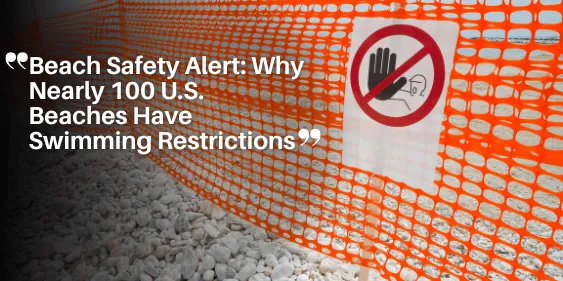Beach Safety Alert: Why Nearly 100 U.S. Beaches Have Swimming Restrictions

As the Fourth of July holiday approaches, beachgoers across the U.S. face the disappointment of swimming restrictions at nearly 100 beaches nationwide.
High levels of bacteria in the water have led to advisories and closures, leaving many wary of taking a dip.
Rising Bacteria Levels
Beach enthusiasts from states like Florida, Illinois, Michigan, New Jersey, New York, and Vermont are particularly impacted.
The contamination primarily stems from fecal waste and cyanobacteria, or blue-green algae, presenting serious health risks.
Elevated bacteria levels can cause gastrointestinal illnesses and skin infections, especially in vulnerable populations such as children and the elderly.
Widespread Impact
These closures aren’t just a local issue; they affect popular coastal spots and beloved holiday destinations.
In Massachusetts alone, 34 beaches have been closed due to unsafe levels of E. coli or enterococci.
Heavy rainfall exacerbates the problem by washing bacteria into swimming areas, further driving the need for precautionary measures.
Dampening Holiday Spirits
Warnings and closures during the much-anticipated Fourth of July holiday season undoubtedly dampen holiday plans.
Regular beachgoers are urged to stay informed by checking health department updates and observing posted safety warnings at beach entrances—a crucial step for ensuring safe and enjoyable outings.
Being vigilant about current beach conditions is key to avoiding health risks and enjoying summer activities.
As we delve into the sources of contamination, it becomes clear how significant climate and environmental factors are in influencing coastal health.
Sources of Contamination
Primary Contaminants
The main culprits of beach contamination are fecal waste and cyanobacteria, also known as blue-green algae.
These contaminants can enter the water through a variety of pathways, including runoff from urban areas and agricultural lands.
High levels of these pollutants are particularly concerning as they can pose significant health risks to beachgoers.
Heavy Rainfall and Its Impact
Heavy rainfall exacerbates the contamination problem.
When it rains heavily, the water can collect bacteria and other pollutants from streets, yards, and farms.
This runoff then finds its way into streams, rivers, and ultimately the beach waters.
The surge in bacteria levels often leads to the closure of affected beach areas, impacting the enjoyment of popular destinations, especially during peak holiday seasons like the Fourth of July.
The Role of Climate Change
Climate change has also been linked to more frequent and severe cyanobacterial algal blooms.
Warmer water temperatures and increased nutrient loads from fertilizer runoff encourage the growth of these harmful algae.
Cyanobacteria produce toxins that can lead to long-term health issues if ingested, including damage to the liver and kidneys.
The increasing frequency of these blooms is alarming and underscores the need for enhanced preventative measures.
Understanding these sources of contamination helps us appreciate the complexities of keeping our beaches safe.
The next logical step is to look at the states and specific beaches that have been most impacted by these issues.
Affected States and Beaches
Illinois and Michigan
Illinois and Michigan have been significantly impacted by bacterial contamination.
Illinois has issued advisories for 16 beaches, warning beachgoers of unsafe swimming conditions due to high bacteria levels.
Michigan has also reported two beach closures and five swimming advisories.
These restrictions are responses to detected levels of fecal waste and cyanobacteria contamination, which pose serious health risks.
Vermont and Massachusetts
Vermont has six locations high on alert due to excessive cyanobacteria, advising against swimming in these waters.
Meanwhile, Massachusetts has noted a particularly high number of beach closures, with 34 beaches closed mainly due to elevated levels of E. coli and enterococci.
These bacteria levels often spike following heavy rainfall, which washes pollutants into water bodies.
Popular Destinations
Florida and San Diego are among the popular beach destinations that have also been impacted.
Florida has several beaches in Monroe and Hillsborough counties under advisories for poor water quality due to high levels of enterococci.
In San Diego, three beaches have been closed, and two others have warnings in place, affecting the plans of many holidaying families.
Regional Reports and Precautions
Southeast Virginia is experiencing similar advisories at several sites, highlighting that the issue of bacterial contamination is widespread across the country.
Keeping an eye on local health department websites and posted safety warnings is essential for ensuring a safe and enjoyable beach experience.
This vigilance helps prevent exposure to harmful pathogens, thereby protecting public health.
Transitioning into safer beach practices is crucial as we look to maintain clean and enjoyable recreational areas for everyone.
Health Risks and Consequences
Swimming in contaminated waters isn’t just unpleasant; it can also be dangerous.
High bacteria levels at beaches pose significant health risks, especially to vulnerable groups like children, the elderly, and those with weakened immune systems.
Health Issues from Contaminated Water
When beachgoers swim in polluted waters, they risk a variety of illnesses.
The most common health issues include gastrointestinal illnesses like stomach cramps, diarrhea, and vomiting. Skin infections are also a concern, particularly for those who already have cuts or open wounds.
Vulnerable Populations
Certain groups are more susceptible to the dangers of contaminated water:
- Children: Their developing immune systems make them particularly vulnerable.
- Elderly: Aged individuals often have weakened immune systems, increasing their risk.
- Immunocompromised individuals: Those with health conditions that weaken the immune system are at elevated risk for severe complications from waterborne illnesses.
Long-Term Health Problems
Exposure to cyanobacteria, also known as blue-green algae, can have serious long-term health effects.
Cyanobacterial blooms are becoming more frequent due to climate change, and they produce microcystin, a toxin.
High levels of microcystin can damage the kidneys, liver, or reproductive system if ingested.
Studies indicate that repeated exposure can lead to lifelong health problems, emphasizing the need for caution and prevention.
Understanding these risks underscores the importance of monitoring water quality and taking appropriate safety measures to protect public health.
Monitoring and Safety Measures
Regular Testing of Beach Water Quality
Ensuring the safety of beachgoers starts with meticulous monitoring of water quality. State health departments conduct regular tests to measure bacteria levels, focusing primarily on fecal waste indicators like E. coli and enterococci.
This proactive approach allows for timely detection of hazardous contamination levels, thus preventing potential health risks.
By gathering data frequently, health officials can track trends and identify sources more effectively.
Closure and Advisory Systems
To safeguard public health, states have implemented closure and advisory systems that inform the public about current beach conditions. When contamination levels exceed safe limits, beaches may be closed or advisories issued to warn the public.
For instance, Illinois has advisories for 16 beaches, and Massachusetts recently closed 34 beaches because of high levels of E. coli and enterococci.
These systems are designed to maintain transparency and provide real-time information. Beachgoers can check their local health department’s website for updates and follow on-site warning signs to ensure they swim in safe waters.
Importance of Checking for Updates
Given that bacteria levels can change rapidly, it’s crucial for beachgoers to stay informed.
Frequent checks on health department websites and mobile alerts can provide the latest safety updates.
Whether planning a simple day trip or an extended vacation, checking for contamination alerts shouldn’t be overlooked.
This habit can prevent exposure to harmful bacteria, protecting both individuals and the broader community.
Taking these precautions and staying vigilant greatly enhances the safety and enjoyment of any beach outing.
Beachgoers contribute to a healthier environment by staying informed and adhering to safety recommendations, fostering safer swim conditions for everyone.
Public Action and Prevention
Cleaning up after pets and properly disposing of trash are two simple yet significant steps in preventing bacterial contamination at beaches. Pet waste is a major source of bacteria. Leaving it on the sand can lead to those harmful microbes washing into the water, especially after rain. By ensuring pet droppings are picked up and disposed of properly, beachgoers can drastically reduce this risk.
Another critical measure is proper trash disposal. Litter, especially food waste, can attract wildlife that contributes to the bacterial load in the water.
Bringing your trash to designated bins and encouraging others to do the same helps keep beaches clean and reduces the chances of pollutants making their way into the ocean.
Lastly, staying informed about water quality is crucial. Bacteria levels can fluctuate frequently.
Checking your local health department’s website for updates before heading out can ensure a safe and enjoyable experience.
Taking these preventive actions collectively paves the way for safer swimming conditions and healthier beach environments.
Conclusion: The Future of Beach Safety
Ongoing Vigilance and Responsibility
Ensuring safe beach outings begins with individual vigilance and responsibility.
Beachgoers play a crucial role in maintaining clean and safe beaches by taking simple preventive actions.
Cleaning up after pets and properly disposing of trash are two small but impactful steps that can significantly reduce bacterial contamination in beach waters.
By adopting these habits, individuals contribute to a healthier environment and safer swimming conditions for everyone.
Collective Commitment to Public Health and Environmental Stewardship
The path to safer beaches requires a collective commitment to public health and environmental stewardship.
Communities must work together to monitor and address sources of contamination.
Support from local governments and environmental organizations is vital in implementing effective water quality testing and prompt advisories.
Public awareness and education on the importance of maintaining clean beach environments can further enhance these efforts, fostering a culture of shared responsibility.
Hope for Decreased Bacterial Contamination Through Increased Awareness
With heightened awareness and proactive measures, there is hope for a future with decreased bacterial contamination at beaches.
Ongoing education about the significance of water quality and the impact of human actions is essential.
As more people recognize their role in protecting beach environments, the incidence of harmful bacterial contamination is likely to decline.
This collaborative effort ensures that future generations can enjoy the beauty and recreational opportunities offered by the nation’s coastal spots.
Working together, we can preserve the natural beauty and safety of our beaches for years to come.






